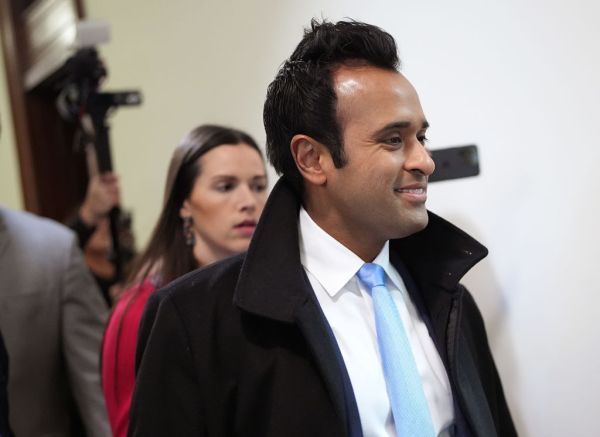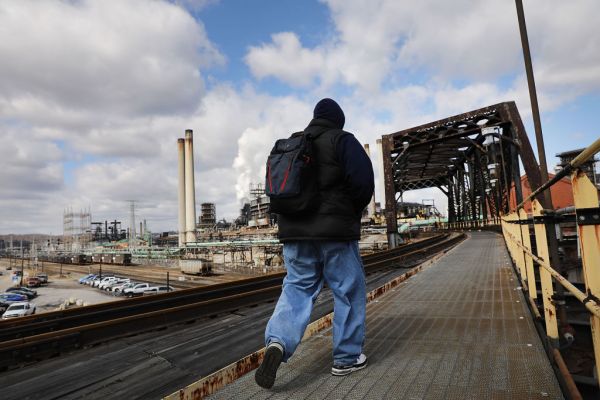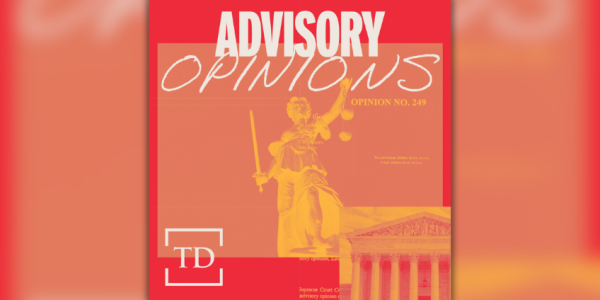Happy Thursday! Big news from The Dispatch: We’re excited to announce the launch next week of Capitolism, an economics newsletter from Scott Lincicome, senior fellow in economic studies at the Cato Institute. Scott, a regular contributor to The Dispatch, will serve as a tour guide of sorts though the often-impenetrable world of federal economic policy, including trade and international economics (which he has taught at Duke University), and virtually anything else related to the exchange of goods and services. At least once a week, Scott will take the latest policy research and data, translate it “into language that normal, non-nerds can more easily understand,” and explain how the outcomes of such policy debates affect the day-to-day lives of Americans. It’ll be illuminating and, odd as it might sound, fun. We promise. Details on how to sign up will follow early next week.
Quick Hits: Today’s Top Stories
-
The United States confirmed 40,289 new cases of COVID-19 yesterday, with 6.2 percent of the 649,741 tests reported coming back positive. An additional 1,075 deaths were attributed to the virus on Wednesday, bringing the pandemic’s American death toll to 185,704.


-
The nonpartisan Congressional Budget Office projected yesterday U.S. debt will equal or exceed the nation’s gross domestic product in 2021 due to the coronavirus pandemic and relief packages that followed. This year’s projected debt-to-GDP ratio—98 percent—is already the largest since World War II.
-
CDC Director Dr. Robert Redfield reportedly sent a letter to governors last week asking them to prepare to have COVID-19 vaccine distribution sites “fully operational” by November 1, 2020. Several vaccine candidates have reached Phase III trials, but Dr. Anthony Fauci said this week those trials could end early if the results are overwhelmingly positive.
-
The Biden campaign and Democratic National Committee announced a whopping $364.5 million fundraising haul in August, the best fundraising month in American political history. The campaign said 57 percent of that total came from online, small-dollar donors.
-
The Commission on Presidential Debates announced Chris Wallace, Steve Scully, Kristen Welker, and Susan Page as moderators for the three upcoming presidential debates and one vice presidential debate, respectively.
-
Sen. Marco Rubio said he expects U.S. intelligence officials will continue briefing the Republican-led Senate Intelligence Committee in-person on election security issues, even as the briefings move to written only for the Democratic-led House Intelligence Committee.
-
Back in March, Daniel T. Prude, a 41-year-old black man, died from asphyxiation when Rochester, N.Y., police suffocated him while trying to take him into protective custody. His family held a news conference Wednesday to make the public aware of police involvement in his death and demand that the officers be fired and charged with homicide.
-
The German government determined that Russian opposition leader Alexei Navalny—who is currently in a coma in Berlin—was poisoned by a chemical nerve agent from the Novichok group. “There are very serious questions now which only the Russian government can and must answer,” German Chancellor Angela Merkel said.
-
Saudi Arabia announced it will allow flights between Israel and the United Arab Emirates to pass through its air space following the latter two countries’ recent normalization deal.
-
A new Gallup poll found that Americans’ perception of race relations in the United States is at its lowest point since 2001. Fifty-five percent of respondents believe relations between white and black Americans are very or somewhat bad; 44 percent believe they are very or somewhat good.
-
The first flurry of high quality, post-convention general election polling was released yesterday, and Joe Biden continues to maintain an approximately 7.5 percentage point lead over Donald Trump in national averages.
Some Good News on COVID

In the midst of the months-long slog through a deadly global pandemic, it can be hard not to fixate on the gloomy and depressing: the drumbeat of another 1,000 or so deaths every day, our leaders’ inability to unite on a virus-fighting strategy, the shell-shocked economy, the anxiety of not knowing how the school year will go. But if you stop and look around, good pandemic news is starting to pile up, too.
Start with yesterday’s big COVID treatment headline: Inexpensive steroid drugs, the World Health Organization declared following a meta-analysis of seven clinical trials, can seriously improve the survival chances of patients seriously sick with COVID, cutting down fatality by about one-third. That’s a more substantial improvement in outcomes than we’ve seen from Remdesivir, the only other drug that gold-standard clinical trials have shown to help critically ill patients at all. In light of this fact, the WHO has now declared steroid treatments to be the front-line treatment for terribly ill COVID patients.
It’s important to take this news in context. First, while these studies and accompanying WHO declaration are certainly significant, we shouldn’t necessarily expect to see an enormous drop in the COVID fatality rate in the days ahead. There’s a simple reason for this: Many doctors have already been treating very sick COVID patients with steroids despite the previous lack of rock-solid study data, simply because they’re a common anti-inflammatory treatment that seemed to show some results during the kitchen-sink phase of the early fight against COVID.
Further, we should note that steroids aren’t intended to fight the virus itself, but one of its most dangerous secondary effects: the berserk autoimmune reaction to the virus known as a cytokine storm. In other words, while we’ve seemingly landed on a powerful treatment to help manage one of the most prominent ways in which COVID can mess you up, there’s still work to be done in terms of treating or curing the actual infection.
That being said, this is still really good news, primarily because it helps to recontextualize promising data on COVID deaths that we already have. When cases spiked around the country in June and July, deaths crept up again too, but we didn’t we see a return to the same brutal numbers we saw in April and May. In a piece for the site a few weeks back, Andrew discussed the difficulty of drawing concrete conclusions from that fact, because of the number of contributing factors involved, including changes to our epidemiological strategy and the changing state of our national COVID testing regime. What this latest data shows, more concretely than we’d been able to say before, is that a big part of that dip in deaths is attributable to improving treatment mechanisms—which means we should be able to expect at least modest continued improvement on that front in the days ahead.
On top of this happy development, there’s also the ongoing encouraging trends in the topline pandemic trends in America. Although economic reopening has continued across much of the country over the summer, every 20,000-foot metric of the pandemic moved in the right direction all through August—after peaking in late July north of 60,000 new cases per day, we’re now seeing just over half that number of cases diagnosed on a daily basis. Deaths, a lagging pandemic indicator, are still hovering around a 1,0000 per day—far higher than we want them to be, but far lower than many had feared we could see during a summer of loosened social restrictions. Meanwhile, our testing apparatus continues to hold its own, at least from a topline perspective: While demand has sagged thanks to the disease’s slowing spread, the major labs conducting COVID tests continue steadily to add new capacity, with the national test positivity rate continuing to slide downward as a result. Gone, for the most part, are the discouraging days of July where widespread testing backlogs meant your test result could be delayed.
Speaking of testing: Ubiquitous rapid antigen testing is coming down the pipe fast. The Trump administration recently announced it is purchasing and will deploy 150 million COVID tests from Abbott Labs, which return results on-site and within minutes. Although questions remain about whether such antigen tests are as reliable as the more labor-intensive PCR tests, deployment of these tests to schools and communities will still likely go a long way toward maintaining some semblance of normalcy until we have a vaccine.
And could a vaccine be within sight? Amid increasing talk of a potential vaccine in the coming months, skeptics have worried publicly that President Trump is putting irresponsible pressure on scientists developing the various potential COVID vaccines in order to ensure one is ready to go by election day. The primary purported evidence for this theory is that the CDC recently instructed U.S. states to put plans in place to be able to distribute a vaccine as early as Nov. 1—which would, of course, be just before Election Day.
We’re not going to say the president would never dream of using the federal pandemic response for political ends. But as of now, that anxiety looks premature. While getting to a vaccine that quickly is by no means a sure thing, it seems in the realm of possibility: Dr. Anthony Fauci, who has shown no qualms about publicly contradicting White House virus messaging in the past, told NBC Wednesday, “I believe that by the time we get to the end of this calendar year that we will feel comfortable that we do have a safe and effective vaccine.” And if that’s a possibility, then of course we want to have a plan in place comfortably ahead of time to distribute it as quickly as it can be manufactured.
Little fragments of encouraging news can be found all over. The University of Arizona recently announced it had caught and shut down a potential coronavirus outbreak before it even began thanks to its deployment of a wastewater testing program—a system in which the sewage output of campus buildings was sampled and tested for traces of the coronavirus. As testing data has accumulated, the FDA has recently relaxed rules to enable labs to make use of tests featuring different sample collection methods—meaning that if you go to get tested in the days ahead, you may be lucky enough to escape the unpleasantly invasive brain-scrape Q-tip experience in favor of a far more pleasant nostril swab or saliva sample.
We’ve still got some hard times ahead of us. But progress is progress — and we’ve seen some.
A Look at Biden on Debt and Deficits
The latest in our series on a prospective Biden presidency comes from Brian Riedl of the Manhattan Institute, who adds up Biden’s spending proposals and … worries.
The big picture:
Despite an unprecedented $24 trillion in budget deficits projected over the next decade, Joe Biden is promising the largest spending spree since Lyndon Johnson. And despite the deepest recession in 80 years, Biden is demanding the largest permanent tax increase since World War II.
The context:
That Biden was portrayed as a moderate during the Democratic primary is a testament to how far left his party has galloped. While his proposed $11 trillion in new spending is significantly less than that proposed by Elizabeth Warren and Biden running mate Kamala Harris ($40 trillion each), or Bernie Sanders (an unfathomable $97 trillion), Biden’s figure still represents an 18 percent spending hike over the already-accelerating spending baseline. It also dwarfs the previous three Democratic presidential nominees—John Kerry, Barack Obama, and Hillary Clinton—who each proposed federal spending expansions of between $1 trillion and $2 trillion over the subsequent decade. Those candidates also proposed roughly equivalent tax increases (with varying credibility) to at least give lip service to controlling the deficit.
And the implications:
Even before the coronavirus pandemic shut down much of the economy, the annual budget deficit was already on pace to surpass $1 trillion this year on the way to $2 trillion within a decade under current policies. The main debt driver is the retirement of 74 million baby boomers into Social Security and Medicare—causing these programs to run an estimated cash shortfall of $11.5 trillion over the next decade. Additional deficit contributors include $2.5 trillion from the Trump tax cuts (if renewed), $2 trillion in higher discretionary spending, and now a staggering $8 trillion (and counting) in higher spending and less tax revenue from the current recession.
Altogether, the national debt held by the public—which was $17 trillion at the end of 2019—is projected to exceed $35 trillion by 2030 under a current-policy baseline. At 114 percent of GDP, that debt level would easily surpass the previous record set at the height of World War II. And it will continue growing steeply in future decades due to the projected $100 trillion cash shortfalls projected for Social Security and Medicare over the next three decades.
Read the whole thing.
The CDC’s Eviction Moratorium
Citing concerns over additional spread of COVID-19, the Centers for Disease Control and Prevention (CDC) on Tuesday issued a temporary eviction moratorium. The emergency order was invoked as an emergency action under Section 361 of the Public Health Service Act and will be effective through the end of the year.
With talks between Republican and Democratic leaders over an additional coronavirus relief package breaking down last month, the CDC’s emergency order will bypass Congress and get aid to socioeconomically vulnerable Americans who may have otherwise been out on the street. But some journalists and legal experts are warning that the policy subverts the separation of powers and strips landlords of their property rights, setting a dangerous precedent for the future of administrative law.
“Eviction moratoria facilitate self-isolation by people who become ill or who are at risk for severe illness from COVID-19 due to an underlying medical condition,” the order reads. “They also allow state and local authorities to more easily implement stay-at-home and social distancing directives to mitigate the community spread of COVID-19.” The policy does not apply to jurisdictions that already have eviction moratoria and applies in every U.S. territory except for American Samoa.
The legal justification for this order is flimsy at best. The CDC claims authorization under 42 CFR Section 70.2, a regulation that allows the CDC director to “take such measures to prevent such spread of the [communicable] diseases as he/she deems reasonably necessary, including inspection, fumigation, disinfection, sanitation, pest extermination, and destruction of animals or articles believed to be sources of infection.”
As constitutional law professor Josh Blackman argues in Reason this week, a nationwide moratorium on evictions doesn’t seem like it should pass muster under this regulatory standard. “This eviction moratorium lacks even a patina of statutory authorization,” he writes. “Landlords can, and should challenge this executive action.”
Before renters can use this emergency order as a defense against eviction from their landlords, however, they must declare under sworn testimony that they meet certain criteria. First, individuals must declare under penalty of perjury that they have used their “best efforts to obtain all available government assistance for rent or housing.” Second, they must also certify that they either do not expect an income that exceeds $99,000 this year (or $198,000 if they are filing a joint tax return), were not required to report income to the IRS last year, or received a stimulus check under the CARES Act.
Tenants must also certify that they are “unable to pay the full rent or make a full housing payment due to substantial loss of household income, loss of compensable hours of work or wages, a lay-off, or extraordinary out-of-pocket medical expenses.” Finally, they must declare that they have tried to the best of their ability to pay rent on time, and that an eviction notice would likely result in homelessness or a shared living space.
It’s worth noting that renters are still bound to their landlord’s terms and conditions, meaning they can be evicted for reasons unrelated to not paying rent on time. The order also does not absolve renters of their rent payments or any other contract obligations associated with their lease. According to American Enterprise Institute economist Stan Veuger, this temporary recourse means that renters might be even worse off if they decide to defer their rent payments under the order and rack up debt that will have to be paid off later on. “When the moratorium period ends, they will just be in deeper financial trouble,” he tells The Dispatch. “And to the extent that they really needed the moratorium, presumably it won’t be that easy for them to dig out of that hole.”
The order came as a surprise to some economists, who generally view eviction moratoria as a policy that is undertaken on the local level. “It wouldn’t normally strike me as the federal government’s responsibility to regulate local rental conditions,” Veuger told The Dispatch. “Whether you agree with the substance of the policy or not, I just don’t think this is how we should [deal] with the most basic property rights. … It seems very very aggressive, and it goes beyond what states like California and New York currently have on the books.”
On Monday, California Gov. Gavin Newson signed into law an extension of the state’s eviction order through February before provisions were set to expire yesterday.
Rather than raising taxes on everyone and giving money to financially vulnerable Americans who need it most, the moratorium arbitrarily shifts the burden to landlords, many of whom are worried about what this means for their own financial stability. “Without direct rental assistance, rents cannot be paid, and owners face a financial crisis of their own by not being able to maintain properties and pay their mortgages or property taxes,” the National Apartment Association said in a statement on Tuesday.
Worth Your Time
-
Last week, NPR Code Switch published an interview with author Vicky Osterweil, who views looting as “a powerful tool to bring about real, lasting change in society.” Graeme Wood is grateful Osterweil had a platform to share her thoughts, although he disagrees with them vehemently. “She has taken up a position that others espouse implicitly. A full exploration of that position is exactly what we need, and Code Switch found its best defender” he writes in a piece for The Atlantic. “If Osterweil’s defense is a bad one, she has now given other pro-looters a chance to reply to it and say why. If they do not, we can assume that they agree with Osterweil, and her argument is the pinnacle of looting apologia. A week ago, you could have said that looting might not be so bad, and I might have wondered what you meant by that. Now I will ask you if your reasons are the same as Osterweil’s, and I will make fun of you if you say yes. This is progress.”
-
Los Angeles Angels starting pitcher Tyler Skaggs died unexpectedly last July at 27. A few weeks later, an autopsy revealed the cause: opioid overdose. A year and change later, Bleacher Report’s Mirin Fader revisited Skaggs’ death, speaking with Tyler’s widow, his mother, and his friends and teammates about their loss—and how someone who seemingly had it all could still succumb to the grip of narcotics. “I’ve known him for over 20 years,’ Skaggs’ friend Scott Heineman said. “I could have never guessed it in a million years. He never gave the impression that he was using. You didn’t see it.”
Presented Without Comment
Also Presented Without Comment
Toeing the Company Line
-
Another Wednesday, another Dispatch Podcast! Andrew filled in for David this week, and joined Sarah, Steve, and Jonah for a discussion of the political fallout of unrest in Kenosha, media bias and market incentives, the race for control of the Senate, and the latest on foreign election interference. Tune in here!
-
Much like Michael Jordan making his triumphant return in 1995, Jonah’s Wednesday G-File (🔒) begins with a simple phrase: “I’m back.” This week’s missive focuses on ideas, and whether or not they can be “young.” The answer, Jonah concludes, is rarely. “There are very few new ideas and there are even fewer new good ideas,” he writes. “That is the enduring curse of civilization: It is constantly beset by invading hordes of people who literally have no idea what came before the moment they were born.”
-
The Pentagon this week released its annual report detailing the military prowess of the People’s Republic of China, and Thomas Joscelyn broke it all down in the latest edition of Vital Interests (🔒). “The days of unquestionable American military supremacy are over,” he concludes. “That’s not to say the Chinese are set to dominate the U.S. The CCP faces many challenges ahead, and America still has the lead in some key technologies. But the rise of China’s People’s Liberation Army, Navy and Air Force clearly spooks the U.S. military—and for good reasons.”
-
Today’s episode of The Remnant gets out of the muck of domestic politics for a conversation with veteran guest Kenneth Pollack on the intricacies of the Israel-UAE deal. Tune in for a conversation on what the deal means for the region and what its historical corollaries are.
-
On the site today, Dr. Akino Yamashita walks readers through the process of filling out a COVID-related death certificate. It sounds morbid, but it helps debunk the viral claim that only 9,200 Americans have actually died from coronavirus infections, based on the CDC indicating that just 6 percent of deaths can be attributed “only to COVID-19.”
Let Us Know
We’ve come a long way together since we wrote to you about the coronavirus in January and February. As we mentioned above, we’re not out of the woods yet. But now’s as good a time as any to reflect on the past few months.
Setting aside various government’s responses to the virus—we’ve hashed that out plenty in the comments the past few months—what would you personally do differently in March and April if you knew then what you know now? Spent more time outside? Hunkered down in a different location? Bought less (or more) toilet paper?
Reporting by Declan Garvey (@declanpgarvey), Andrew Egger (@EggerDC), Charlotte Lawson (@charlotteUVA), Audrey Fahlberg (@FahlOutBerg), James P. Sutton (@jamespsuttonsf), and Steve Hayes (@stephenfhayes).
Photograph by Jakub Porzycki/NurPhoto/Getty Images.








Please note that we at The Dispatch hold ourselves, our work, and our commenters to a higher standard than other places on the internet. We welcome comments that foster genuine debate or discussion—including comments critical of us or our work—but responses that include ad hominem attacks on fellow Dispatch members or are intended to stoke fear and anger may be moderated.
You are currently using a limited time guest pass and do not have access to commenting. Consider subscribing to join the conversation.
With your membership, you only have the ability to comment on The Morning Dispatch articles. Consider upgrading to join the conversation everywhere.